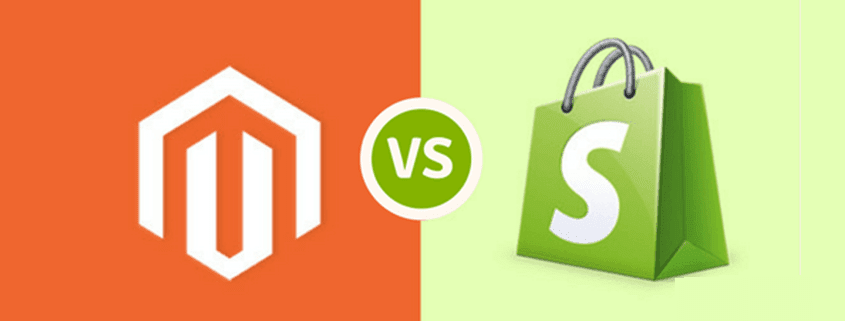Magento vs Shopify: What should You Choose?

Magento vs Shopify: What should You Choose?
Of the many competitors jostling for being the platform of choice in eCommerce website development, two names stand out: Magento and Shopify. Since quite some time, there seems to have been a never-ending debate: When it boils down to Magento vs Shopify, what platform should you choose for your online shop?
What makes the Shopify vs Magento debate really, really interesting (and difficult) is the fact that the two couldn’t be more different! Both empower their shop-owners with features that serve similar purposes, yet are handed out very differently. Both offer huge scope for customization, yet they take routes that are distinct. Both also have some unique limitations and yet are amazingly powerful in their own ways.
Primary comparison: Magento vs Shopify
First things first.
Magento is a free, open-source software which means you can make as many changes as you want – and as you are technically competent enough to carry out.
Shopify is a commercial, proprietary product. It offers great customization too, but you can’t change its inherent structure.
Magento does not have its own hosting. In other words, Magento gives you the freedom to select your own hosting provider.
Shopify, on the other hand, is a hosted solution. That means it hosts your shop.
Finally, Magento requires you yourself carry out the installation, setting up and configuring.
Shopify does almost all of this for you and saves you a lot of effort. For a fee, of course.
To summarize the first round of comparison of Shopify vs Magento, one can say Shopify is a paid SaaS that does a lot of things for you, while Magento is free and open-source, so you’ll be doing a lot of stuff yourself.
Now let’s dig a little deeper.
Convenience and Ease of Use
Magento, as said earlier, requires you to do a lot of things by yourself. Of course, there are numerous 3rd party plug-ins that you can use. To begin with, Magento, which uses PHP, requires you to handle all the installations and setting up. This can turn out to be quite complex if you’re short of resources on your team.
The positive side is that with Magento, you get great flexibility. Since a number of things are in your hands, you can carry out changes to suit your requirements. Assuming your team is technically skilled, you’ll love the kind of freedom Magento gives you.
Shopify, like the typical SaaS (Software as a Service), charges you a monthly fee, starting $29/mo onwards. Against the fees, it will make your installation and set up a great deal easier. That’s because Shopify will take care of the coding part and you’ll be required to only make selections and click your choices.
The downside, if it can be called a downside, is that Shopify is a closed platform. If you’re a coder who prefers freedom, Shopify may not please you since it will not allow much flexibility.
So if you are skilled – and ready to invest time – Magento presents a better case. Non-technical people or beginners, on the other hand, will prefer Shopify. In other words, when it’s Shopify vs Magento, Shopify wins at the entry level.
Support, Hosting and Miscellaneous Features
Shopify has a 24×7 support available that has you covered. You can email or phone Support, or communicate with the Support and can be sure you’ll be responded to. Anytime you’re stuck, you know Support will solve the issue.
Magento Community Edition (CE) does not have any support; Enterprise Edition (EE) does. You have done the setting up, so are pretty much to yourself. However, as a result, a huge community has developed over time that extremely helpful. Its members share their experiences, report likely issues and generously offer help.
With Magento, you’ve chosen your own hosting service provider. In case you tried to drive down costs by choosing a low-end hosting-provider, you must also be ready for the associated risks.
Shopify, on the other hand, has handled the hosting on your behalf, just as it does for each of its thousands of clients, backup and security is pretty much a given. You can be assured of automatic backups and the strong security measures.
Finally, Magento offers you a very wide range of themes to choose from, starting very low in the cost range. You get to choose from the big number of templates too. Additionally, there are a great number of add-ons and apps that can easily fit into your Magento-built store.
Magento also offers a good range of multilingual capabilities, something that Shopify doesn’t offer directly; you’ve found a way around. Magento being fully community-driven, you get a much bigger number of apps and add-ons. In comparison, Shopify’s range of apps is quite limited.
Costing and Payment Gateways
As said earlier, Shopify is a paid, commercial product; Magento CE is free. (Of course, you may need to hire Magento developer, so that’s an additional cost.) This can be an important consideration for developers and small businesses when they are conducting a study of Magento vs Shopify.
Shopify offers a 14-day free trial, after which you can choose from its packages. Its basic package begins at $28/mo. As you move towards bigger packages, you get more features like better analytics, abandoned carts revivals and so on. It’s important to note that such features, although from 3rd parties, cost significantly less with Magento.
When you’re building your shop using Magento, you’ll need to separately buy domain names and hosting. You’ll not want to compromise on hosting, because that, in turn, can impact the speed of your site. Therefore think carefully before you select a hosting provider. Shopify packages, on the other hand, cover these things so there are no additional charges.
As for the payments, if you use PayPal, Authorize.net, or a similar external payment gateway, Shopify charges transactions fees. Bigger the monthly package you’ve opted for, smaller the percentage of these transaction fees. There’s, however, an alternative. If you opt for Shopify’s direct payment gateway, you are exempt from the transaction fees.
Some costs remain extra for both these. For instance, any additional add-ons you want on your site will cost extra, irrespective of the platform. (Some add-ons on Magento are free; you may use them if you trust the source.)
Scalability and Capacity
In the Shopify vs Magento debate, another important factor is scalability. For small shops that have limited or no access to technical resources, Shopify is way better. That’s because almost everything is ready-made and any add-ons required can be easily put to use like plug-and-play.
For large-scale stores with multiple and varied requirements, it’s difficult to beat Magento. That’s because of the tremendous customization it offers. Even though your store is currently small, if you expect to grow quickly and grow big, you’d be better off opting for Magento.
Some of the additional features that large-store owners like about Magento is that it comes with more front-end features like gift-cards and wish-lists and coupon codes. You’ll need to get service from Magento development company as configuring Magento is not easy if you’re not a tech person.
It can safely be concluded that while the small businesses may find it convenient, to begin with, Shopify, bigger businesses – or businesses that are slated to grow big very soon – find Magento a whole lot better.
Design and Marketing Opportunities
To begin with, the proprietary themes of Shopify can be useful to a certain degree. Since you can’t do much of changes with these themes, one of the first limitations you face is in branding – you may be constrained with color combinations, for example. Magento, especially Magento 2, seems to carry a lot of promise into its platform. Its drag and drop editing and hugely customizable design opportunities serve branding options better.
Sorting customers, managing payment processors or handling wish-lists is something Magento 2 has brought near perfection. Shopify used to be better in terms of site-speed (that’s because Magento doesn’t host your site, so your site-speed depends largely upon your hosting service provider), but this difference is likely to vanish with Magento 2. The Magento 2, has certain in-built promotion features like promotional pricing that can be fully exploited but before you think of Magento 2 check the Magento 2 system requirements.
Its new admin panel is easier to manage. And with Magento 2, checkout is fast and distraction free. That goes a long way in reducing cart abandonment, one of the major causes of concern in eCommerce.
Shopify has a Shopify Facebook app, in its search for a better reach. Apart from that, Search Engine Optimization (SEO) and Search Engine Marketing (SEM) are the areas where there isn’t a clear winner between Shopify and Magento. At least on these grounds, the argument of Shopify vs Magento doesn’t produce a clear winner.
Conclusion
One thing that emerges out of this debate is that in the Magento vs Shopify comparison, there is not going to be an overall winner. Almost everything depends on the factors that matter most to you.
If you are looking for something that’s easy like plug-and-play, something that works best from the word goes, probably you’re better off with Shopify. If on the other hand, you prefer doing things yourself and tinkering with every detail, Magento is what you should choose. A general agreement is it’d be a smart decision for small-businesses to opt for Shopify, while big-businesses, especially those that need a good number of customizations, will find Magento better meets their requirements.
Infigic is a custom Magento development service provider that helped a wide range of clients – from startups to large corporates. Looking for Magento eCommerce development, Contact us to find out more about how our expertise can make a big difference to your business!











